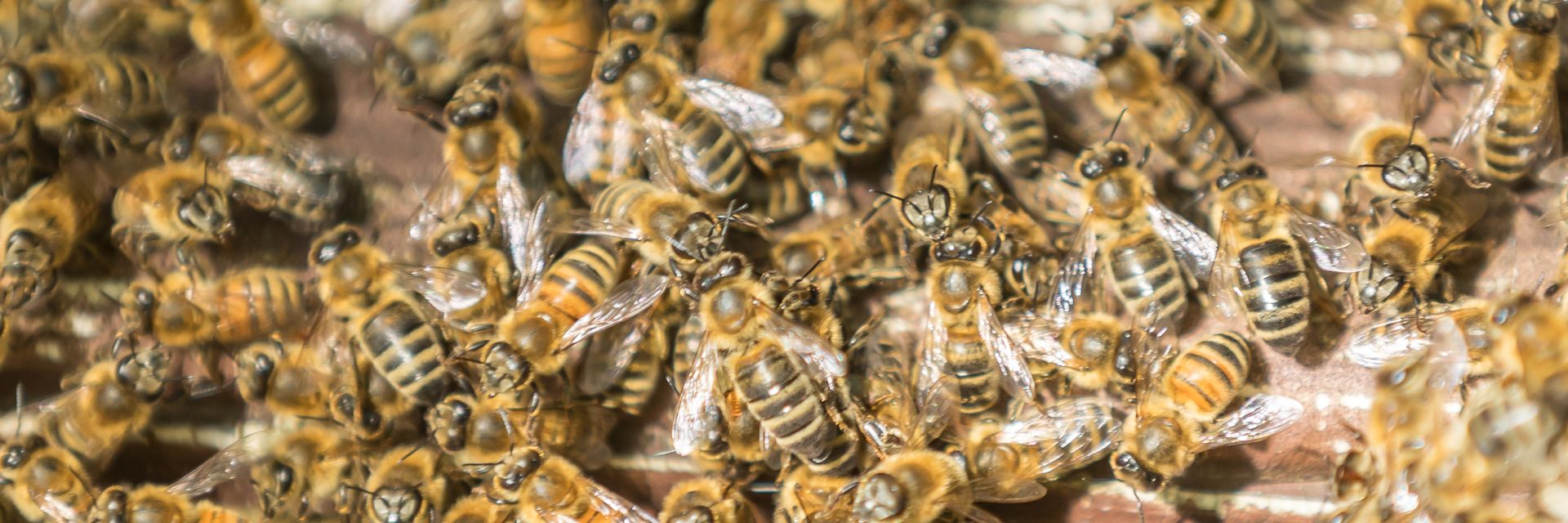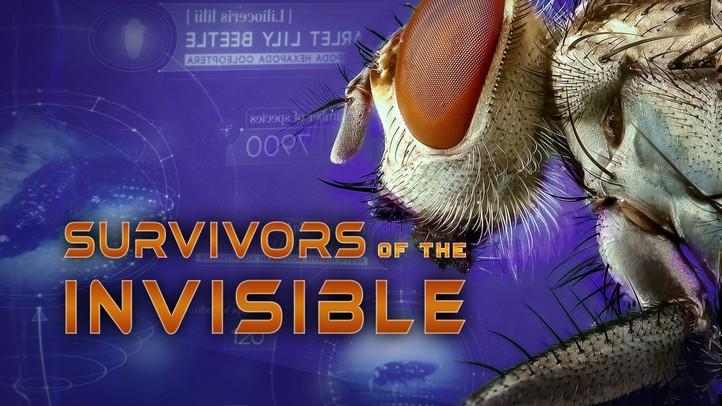Almost 60 years ago, Rachel Carson’s Silent Spring sounded the warning that the pesticide DDT was decimating ecologically critical insect populations, along with the animals that fed on them. Today, the combination of habitat destruction, seasonal shifts due to global climate change, and a new generation of pesticides like neonicotinoids has dramatically increased the threat to beneficial insects. Can we respond in time, or will we finally suffer the consequences of Carson’s ‘silent spring’?
◊
When I was growing up in small-town Florida, my dad sometimes took us for a drive after dinner. (What else was there to do, other than watching black-and-white TV on a small screen in a cramped, low-ceilinged living room?) In warm, summer months particularly, we often saw the familiar clouds sprayed out by the mosquito-control truck and inhaled its sweet, overpowering aroma. It was oddly pleasant, like a floral scent, but we knew it was unsafe. Signs on the truck advised against following it too closely, but on lonely, two-lane roads, it was sometimes unavoidable.
That was in the early 1960s, when widely used pesticides were hailed for their ability to boost crop yields and rid dangerous pests such as disease-carrying mosquitoes and dreaded locusts from the environment. Eventually, however, the clear and present dangers of DDT – the mosquito-killing agent – became widely known.
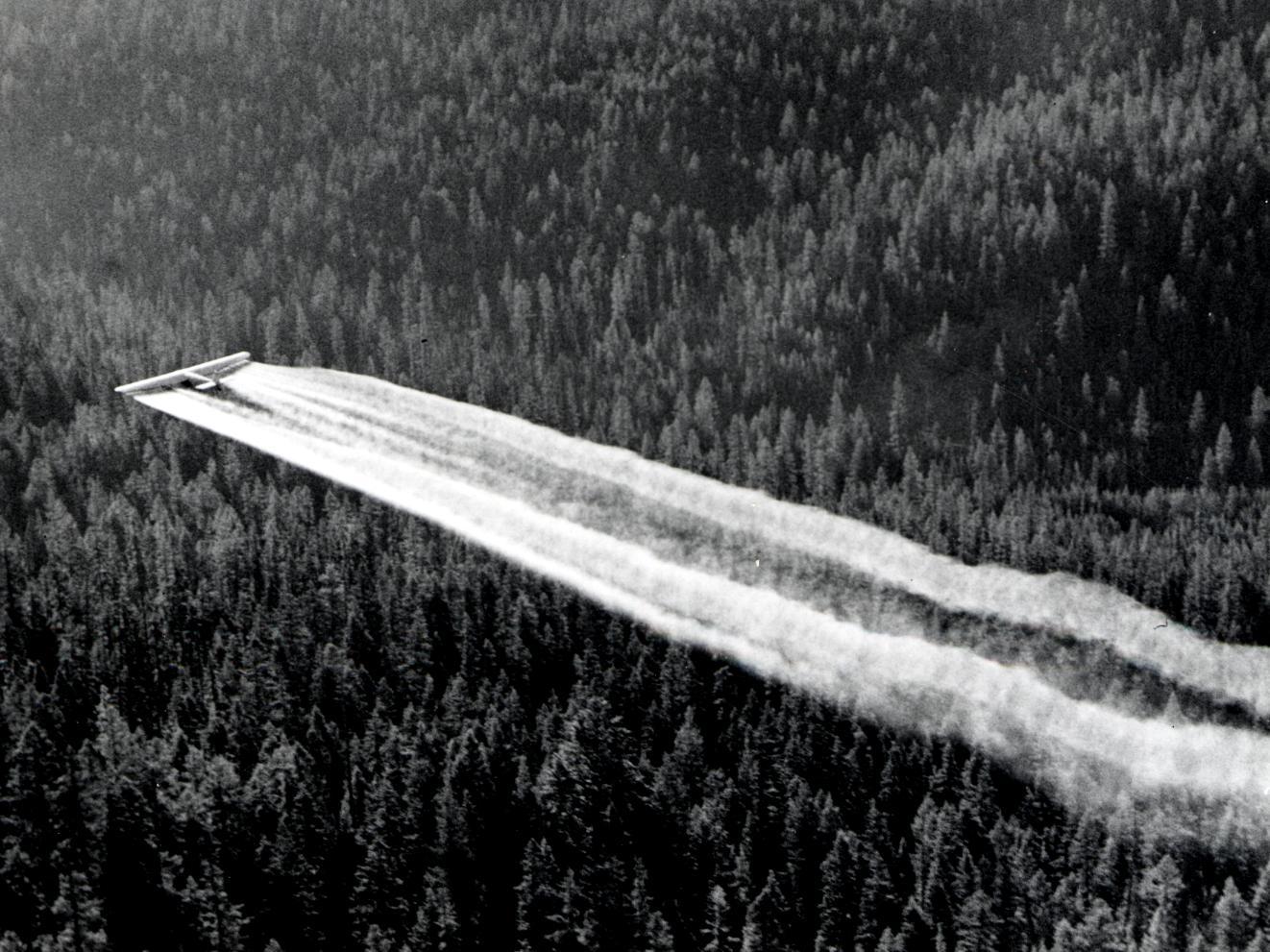
Ford tri-motor spraying DDT, Powder River, Oregon, 1955 (Credit: R.B. Pope, via Wikimedia Commons)
In 1962, naturalist and science writer Rachel Carson published Silent Spring, a groundbreaking book on the effects, intended and unintended, of indiscriminate pesticide use. By the mid-1960s, when Carson’s book was being discussed widely in the news and in Congressional hearings, my family had left Florida, and I never learned what happened to those rumbling mosquito trucks.
Silent Spring Signals a Warning, and People Respond
I can tell you what happened to DDT, though. In Silent Spring, Carson argued that DDT was all too effective as a pesticide. While it poisoned invasive species, including such unwanted bugs as mosquitos and fire ants, its poison didn’t stop there. Carson showed that DDT killed welcome insects as well; it also killed animals that feed on insects, such as birds. And residue from DDT and similar agents even seeped into groundwater, spreading poison into other plants and the animals that fed on them.
A key message of Silent Spring is that a powerful killer like DDT has the capacity to spread into the food chains of insects and larger creatures. The “silent spring” of Carson’s title was the potential for much of our living environment to disappear. She demonstrated that DDT could literally cause birds to fall from the sky, silencing their songs. This loss would disrupt natural processes all through the natural kingdom, eventually causing deleterious effects on humans.
This was a controversial topic in the 1960s, to be sure. Insecticides were big business, not only on the farm but in more heavily populated areas as well, and were (and still are) marketed to combat home pest infestation. But Silent Spring, despite well-organized and well-funded p.r. campaigns by chemical pesticide manufacturers, made its point. Still, it took a decade, till 1972, DDT was effectively banned for use in the U.S.
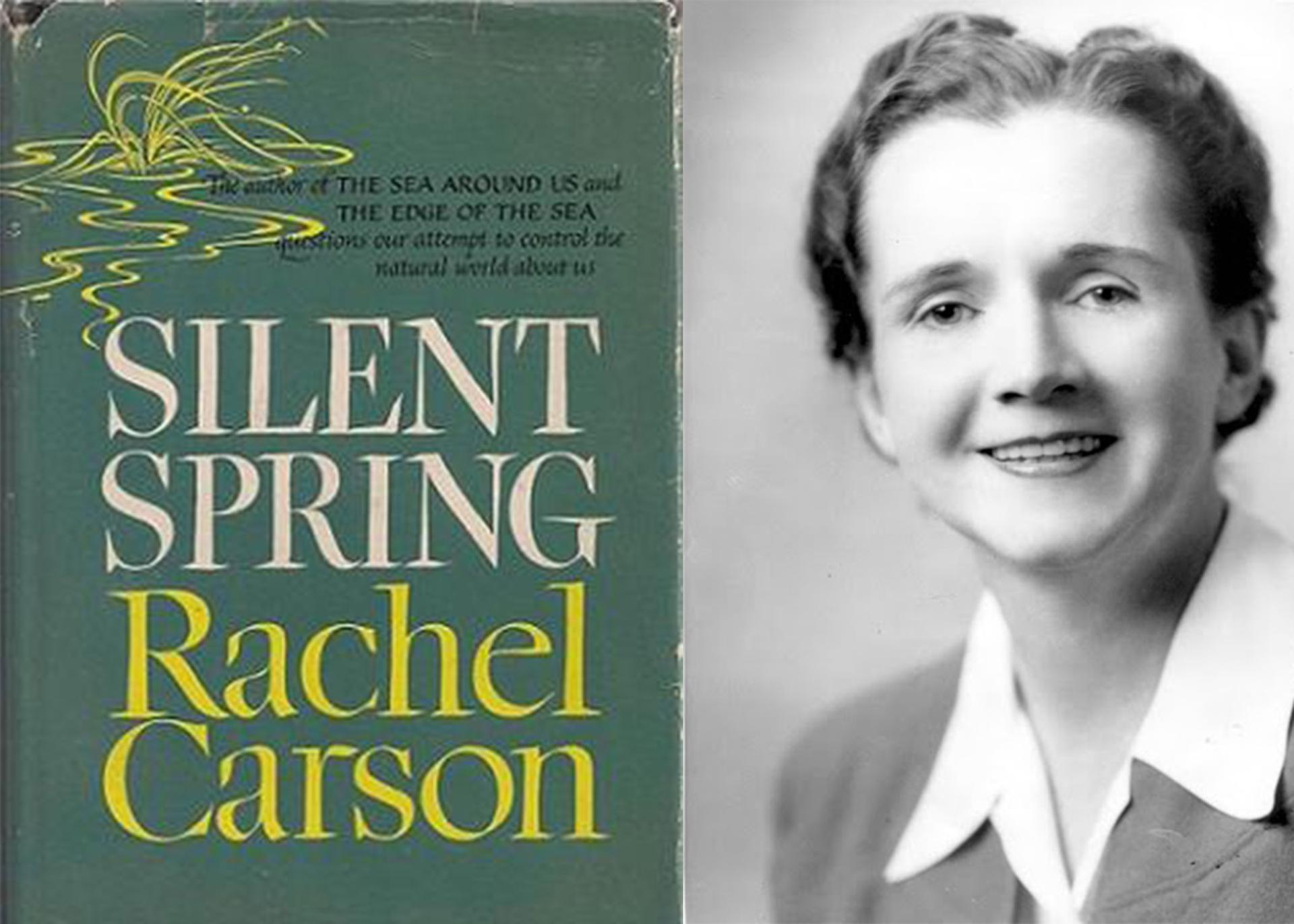
What Came After DDT? The Rise of Neonicotinoids
The banning of DDT in the United States and elsewhere left a hole in farmers’ arsenals to fight pests that could ruin crops. Chemical manufacturers looked for alternatives that were safer – or at least legal – for high-density use in agribusiness. Since the 1980s, and rapidly escalating from the 1990s to now, the weapon of choice against pests, is a class of insecticides known as neonicotinoids. These chemicals are highly toxic to insects and, their manufacturers insist, harmless to humans.
But many scientists disagree with this rosy assessment. (The European Union banned all outdoor use of neonicotinoids in 2018.) The problems once associated with DDT are with us again, and are even more pervasive, worrying, and widespread. More than prospective, as in the writings of Rachel Carson, there is accumulating scientific evidence that the “silent spring” she predicted is closer to reality than ever. Though it may seem to you that there are plenty of minute pests and other creepy-crawling insects to go around, in reality their numbers are dwindling throughout the populated world. There’s even a catchy term for the loss of insects in our world: the “windshield phenomenon.”
For a deeper dive into the small-scale worlds of insects – one with great import for our own grand-scale world – take a look at the MagellanTV documentary Survivors of the Invisible.
Why this name? If “windshield phenomenon” isn’t evocative to you, it may be that you’re too young to remember long drives in the family car in spring or summer, and the many flying-insect carcasses that had to be wiped off the windshield with wipers and washers, elbow grease, or some combination of the three. Maybe that is a distant memory you can recall, but it’s probably not a recent one. There are simply not enough swarming insects left nowadays to make an impression on your windshield (or “windscreen” should you live in Britain or one of its former colonies).
The Threat to Insects and the Animal Food Chain Amid Rapid Ecological Shifts
How did this alarming situation come to pass? Pesticide use is surely one of the culprits in the reduced numbers of swarming insects in the wild, but that is merely one of three swift punches insect populations are absorbing simultaneously. The other two? Climate change and wildlife habitat destruction and degradation. But assigning the relative share of responsibility is practically impossible, as all contribute to the “silencing” of nature.
Here’s one simple example based on how climate and seasonal changes are affecting wildlife. In many areas in the Northern Hemisphere, insects are emerging earlier after winter than previously. One study found that insects now hatch one month earlier than they did 50 or more years ago. The same study notes that birds lay eggs earlier, but by only one week rather than a month. This has resulted in their life cycles becoming “out-of-sync,” and therefore feeding cycles are being disrupted. Bird populations are suffering, and farming cycles are being affected as well.
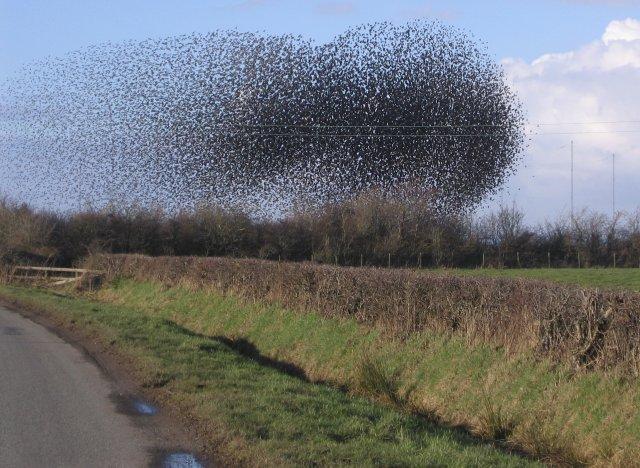
Flock of starlings acting as a swarm (Credit: John Holmes, via Wikimedia Commons)
A 2014 study published in Science magazine showed that, over the past human generation, there has been a 45 percent decline in monitored insect species, including beetles, bees, moths, and butterflies. And larger animals that rely on insects are declining as well. Over three decades, in fact, there’s been a 50 percent decline in farmland birds in Europe, such as nightingales and turtle doves. (Not all of this is due to the decline in insects; modern agriculture techniques also threaten farmland birds, and habitat destruction and predation by cats cause the decline as well.)
Habitat disappearance, which displaces natural populations as unpopulated lands are developed, is showing effects in insect numbers. Even in areas that have regulated the use of pesticides, such as Canada and the countries of the E.U., numbers are still decreasing. Scientists are noting the “collapse” of the forest food web as animals must contend with:
- Shifting cues from nature for when to mate, migrate, and hunt prey.
- Loss of habitat reducing nesting and hunting areas.
- Meager food resources resulting from prey populations being stressed as well.
How Neonicotinoids Work on Bees and Other Living Things
Of all these threats, perhaps the most pernicious (and yet, most easily altered) is the use of neonicotinoids on crops. Since the use of DDT was curtailed in the 1970s, this class of pesticide accounts for 92 percent of increased toxicity among pest control tactics.
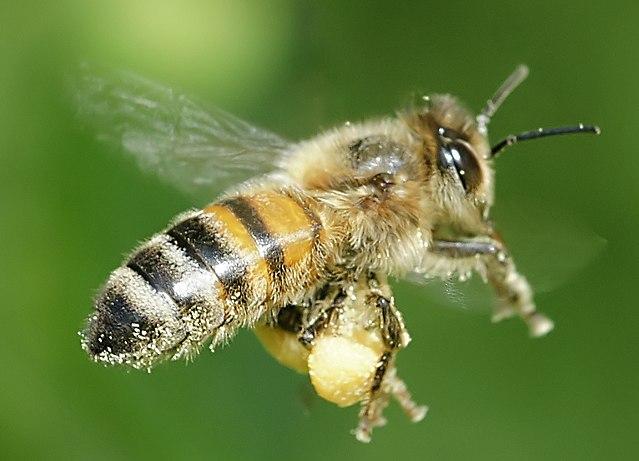
Apis mellifera (Credit: Hans Hillewaert, via Wikimedia Commons)
Called neonics for short, these chemicals coat agricultural seeds and subsequently infiltrate all aspects and parts of the plant. Leaves, stalks, fruit, even castoff dead parts of the plant maintain their toxicity. They are also water-soluble, and seep into groundwater to contaminate the regional water supply. Known as “systemic insecticides,” neonics have many deleterious effects on such non-targeted subjects as bees and butterflies.
Studies show that neonics are absorbed into insects’ life systems. For bees, they are known to affect bees’ ability to navigate. This one facet alone goes a long way to explain the shocking rise in what’s known as hive collapse; if the bees can’t find their ways back to the hive, they’re lost for good, and the hive is decimated. But that’s not all: Neonics alter bees’ immune function and impair their reproductive ability.
While neonics may not kill bees or other insects on contact, the effect is still lethal. When impaired, the bees’ life cycle is dramatically shortened and their effectiveness as a part of a colony is terminated.
The Chemical Industry Strikes Back: “Neonicotinoids Are Safe!”
In the late 1950s and early ’60s, Rachel Carson was shocked to attend Congressional hearings on the safety of DDT and hear representatives of chemical-producing agencies – as well as members of the U.S. Department of Agriculture – defend the use of DDT as safe, when her own research contradicted their testimony. And things haven’t really changed over the years since.
In the U.S. today, chemical manufacturers routinely defend the level of neonics’ use as safe and harmless to the environment when applied as directed, and the current Environmental Protection Agency approves. According to a February 2020 report in Chemical and Engineering News, “CropLife America, which represents pesticide manufacturers, claims . . . ‘neonics are effective in controlling harmful insects . . . with no unreasonable adverse effects on pollinator health when used according to label instructions.’”
Many industry observers disagree. For one, the National Resources Defense Council warns that neonics are “a major player in the broader biodiversity crisis. Neonics are highly ecologically toxic, persistent, and all over the environment. The popular pesticides have been linked to harms to native pollinators and insects, fish, birds, deer, bats, aquatic ecosystems, and other wildlife, as well as widespread soil and water contamination.”
What Can You Do? (The Answers May Surprise You)
No thoughtful, aware person wants to see a Silent Spring-type endpoint for our environment. A world without pollinators, with decimated bird populations and failing plant and animal life, is a dystopian future for all.
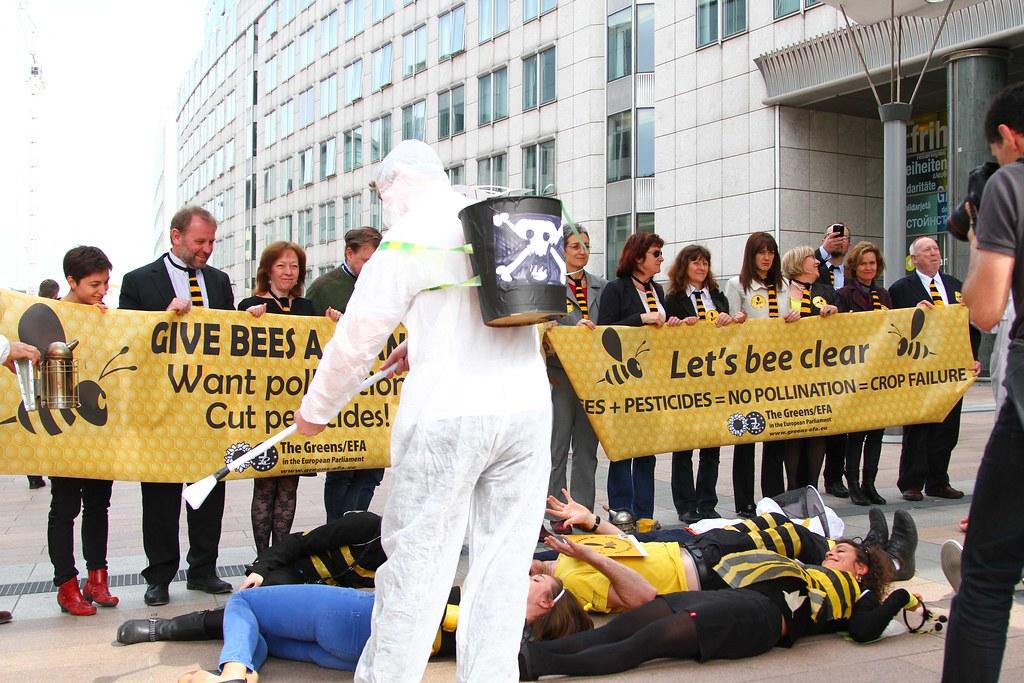
Die-in of bees and beekeepers at European Parliament in Brussels, 2014 (Credit: Greens/EFA, via Citizen Truth)
But there are ways, including personal life adjustments, we can stave off a coming “insect apocalypse.” Here are some tips suggested by a 2019 BBC News article.
- Keep outside lights off. These disturb the natural breeding cycles of moths and glowworms.
- Shop for and consume organic produce. Reduce the amount of pesticides in your system, and contribute to a greater demand for organic methods of crop cultivation.
- Grow your own plants, even if you have only a small space. Plants, especially herbs, are very pollinator-friendly.
- Provide water outside for bird feeding and hydration as appropriate..
- Keep – or welcome – bees, if you have the space (and temperament).
These are, admittedly, small steps. But consider the impact Rachel Carson had on ecology in the 1960s and ’70s. One woman, one voice made an oceanic difference in her times and left a large legacy of environmental activism. Maybe yours will be the voice for our times.
Ω
Kevin Martin is Senior Writer for MagellanTV. He writes on a wide variety of topics, including outer space, the fine arts, and modern history. He has had a long career as a journalist and communications specialist with both nonprofit and for-profit organizations. He resides in Glendale, California.
Title image: Bee colony at Cologne/Bonn Airport by Raimond Spekking via Wikimedia Commons.
